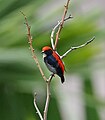
The flowerpeckers are a family, Dicaeidae, of passerine birds. The family comprises two genera, Dicaeum and Prionochilus, with 50 species in total. The family has sometimes been included in an enlarged sunbird family Nectariniidae. The berrypeckers of the family Melanocharitidae and the painted berrypeckers, Paramythiidae, were once lumped into this family as well. The family is distributed through tropical southern Asia and Australasia from India east to the Philippines and south to Australia. The family has a wide range occupying a wide range of environments from sea level to montane habitats. Some species, such as the mistletoebird of Australia, are recorded as being highly nomadic over parts of their range.

The olive-backed sunbird, also known as the yellow-bellied sunbird, is a species of sunbird found from Southern Asia to Australia.

Dicaeum is a genus of birds in the flowerpecker family Dicaeidae, a group of passerines tropical southern Asia and Australasia from India east to the Philippines and south to Australia. The genus Dicaeum is closely related to the genus Prionochilus and forms a monophyletic group.

The thick-billed flowerpecker is a tiny bird in the flowerpecker group. They feed predominantly on fruits and are active birds that are mainly seen in the tops of trees in forests. It is a resident bird with a wide distribution across tropical southern Asia from India east to Indonesia and Timor with several populations recognized as subspecies some of which are sometimes treated as full species.

The red-breasted parakeet is a parrot native to Southeast Asia. It is among the more widespread species of the genus and is the species which has the most geographical variations. It is easily identified by the large red patch on its breast. An alternative name is the moustached parakeet depending on subspecies. Most of the subspecies are confined to minuscule islands or a cluster of islands in Indonesia. One subspecies occurs in the Andaman islands, and one subspecies occurs in continental Southeast Asia and partly extending to northeastern parts of South Asia along the foothills of the Himalayas. Some of the island races may be threatened by the wild bird trade. The nominate race, which occurs in Java, is close to extinction.

The olive-crowned flowerpecker is a small passerine bird in the flowerpecker family, Dicaeidae. It is found in far western New Guinea and on adjacent islands.
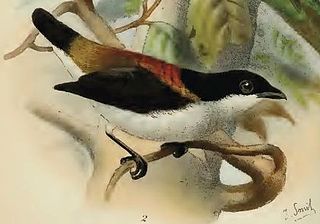
The Cebu flowerpecker is a small passerine bird. It is endemic to Cebu Island in the Philippines. Feared to have become extinct early in the 20th century, it was rediscovered in 1992 in a small patch of limestone forest in the Central Cebu Protected Landscape. It has since been found at three other sites, namely the Nug-as forest of Alcoy, Mount Lantoy of Argao and the forests of Dalaguete. This four-colored bird normally grows to 11 or 12 centimeters. The male is characterized by a large, triangular, scarlet to vermilion coat stain. In the female, the top is brown. The Cebu flowerpecker consumes small fruits and mistletoe plants and is generally active in the mornings to avoid competition with more aggressive birds. Despite attempts to protect its habitat it remains critically endangered due to illegal logging.

The red lory is a species of parrot in the family Psittaculidae. It is the second-most commonly kept lory in captivity, after the rainbow lorikeet.

The yellow-crowned flowerpecker is a species of bird in the family Dicaeidae. It is endemic to Luzon Island in the Philippines. The flame-crowned flowerpecker, which is endemic to Mindanao, was formerly considered conspecific. Its natural habitat is tropical moist montane forest. It is becoming rare due to habitat loss.

The red-keeled flowerpecker or red-striped flowerpecker is a species of bird in the family Dicaeidae. It is endemic to the Philippines. Its natural habitat is subtropical or tropical moist lowland forests. The black-belted flowerpecker was formerly regarded as a subspecies of this bird.
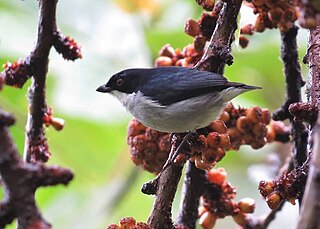
The bicolored flowerpecker is a species of bird in the family Dicaeidae. It is endemic to the Philippines.

The grey-sided flowerpecker is a species of bird in the family Dicaeidae. It is endemic to Indonesia. Its natural habitats are subtropical or tropical moist lowland forest and subtropical or tropical moist montane forest.

The yellow-vented flowerpecker is a species of bird in the family Dicaeidae. It is found in Bangladesh, Bhutan, Brunei, Cambodia, China, India, Indonesia, Laos, Malaysia, Myanmar, Nepal, Singapore, Thailand, and Vietnam. Its natural habitats are subtropical or tropical moist lowland forest and subtropical or tropical moist montane forest. Along with D. melanoxanthum, D. agile, and D. everetti, it is often referred to as an “odd” Dicaeum species because of unique characteristics separating it from other species within the family. While most species have vestigial outermost primary feathers, those of the yellow-vented flowerpecker are elongated.

The fire-breasted flowerpecker is a species of bird in the family Dicaeidae found in the Indian Subcontinent and Southeast Asia. Like other flowerpeckers, this tiny bird feeds on fruits and plays an important role in the dispersal of fruiting plants. Unlike many other species in the genus, this species has marked sexual dimorphism with the male having contrasting upper and lower parts with a distinctive bright orange breast patch. The female is dull coloured.

The black-sided flowerpecker, also known as the Bornean flowerpecker, is a species of bird in the family Dicaeidae. It is endemic to the island of Borneo, where it is found in the mountains, primarily above 1,000 m (3,300 ft) in elevation. The species is sexually dimorphic. The male has glossy blue-black upperparts, with a scarlet throat and breast, a dark grey upper belly, olive flanks, a white lower belly, and a buffy vent and undertail coverts. The female is olive-green above and greyish below, with buffy flanks and a whitish throat. It inhabits a range of forest habitats, including primary and secondary montane forest, kerangas forest, and scrub, and is also occasionally found in gardens. It feeds primarily on small fruits—particularly mistletoe berries—as well as seeds, nectar, and various invertebrates. It builds a nest of moss, camouflaged on the outside with lichens and lined with the pith of tree ferns. The International Union for Conservation of Nature rates it as a species of least concern. Though its numbers have not been quantified, the black-sided flowerpecker is said to be common throughout much of its range, and any declines are not thought to be precipitous. However, destruction of forest for palm plantations may impact it.
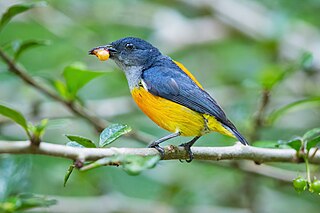
The orange-bellied flowerpecker is a species of bird in the family Dicaeidae. It is found in Bangladesh, Brunei, India, Indonesia, Malaysia, Myanmar, the Philippines, Singapore, and Thailand.

The scarlet-headed flowerpecker is a bird species in the family of Dicaeidae. It is a species endemic to Indonesia. This flowerpecker inhabits a few islands of the archipelago of Indonesia. It is mainly observed in open wooden areas, gardens, and mangroves.

The ashy flowerpecker is a species of bird in the family Dicaeidae. It is endemic to Indonesia where it occurs on Seram, Ambon and nearby islands in the Banda Arc. Its natural habitats are subtropical or tropical moist lowland forest and subtropical or tropical moist montane forest.

The scarlet-chested sunbird is a species of bird in the family Nectariniidae.
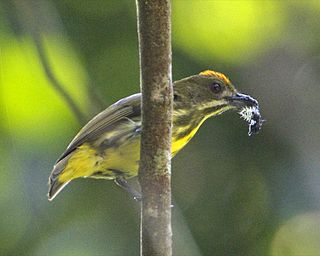
Prionochilus is one of two genera flowerpecker that make up the family Dicaeidae. The genus differs from the other flowerpecker genus, Dicaeum in having ten long primary feathers in the wing and in the character of its calls. A study comparing the calls of the two genera suggested that Prionochilus is basal to Dicaeum. The genus contains six species, in contrast to the 44 species in the genus Dicaeum. They have a more restricted distribution than Dicaeum, occurring in the Philippines, Borneo, Sumatra, Java and the Malay Peninsula. The name Prionochilus is derived from the Greek prion for saw, and kheilos for lip, referring to the minute serrations along the edge of the bill.




